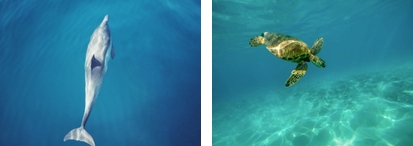Biomimicry is using nature to inspire and improve designs for materials, devices, structures, and processes. The word comes from the Ancient Greek words bios, meaning life, and mimesis, meaning to imitate, so it literally means ‘imitating life’. The concept is that by examining creatures and processes in nature, we can find ideas to engineer better solutions.
Mimicking nature is not a new idea – humans have observed and emulated animals and natural processes for their own benefit for millennia. Some historians suggest that the invention of the wheel thousands of years ago was inspired by dung beetles rolling their egg-filled balls of dung. Famously, Leonardo da Vinci designed a flying machine called the ornithopter in the 25th century that was inspired by the flapping wings of bats, birds, and insects.
Can you think of any things you have seen or use that might have been designed using inspiration from nature?
How about fins for swimming?
It doesn’t take much time in the water to realise that humans are less well suited to underwater movement than dolphins or seals or sea turtles. A simple study of sea creatures moving through the water shows the importance of a streamlined body and large flat flipper(s) for propulsion.

For centuries humans have attached paddles to their hands and feet to act as fins for faster swimming, but it wasn’t until the mid-1900s that more refined designs with flexible material and a sleek triangular shape, inspired by the properties of aquatic animals, were developed and patented. These were first popular with the military for clearing underwater bombs in the second World War but soon became standard equipment for everyday use for work or leisure in any body of water.

How about velcro?
George de Mestral was a Swiss engineer who was intrigued by the way burrs stuck so well to his dog’s fur. He examined the burrs under a microscope and noticed that they were made up of tiny hooks that would cling to anything with a loop, such as fur, hair, or clothing. This feature is important to plants because it enables their seeds within the burrs to be carried far away by passing animals, allowing them to spread and grow widely. Mestral was inspired to design a fastening system using this same hook and loop concept - creating velcro! Velcro is valuable since it can be attached and detached many times without wearing out and it is used in many different applications - from the shoes of a young child who hasn’t yet learned to tie laces to scuba diving equipment that requires a fastener that works underwater.

These two examples of biomimicry show that although engineering design solutions taken from nature often provide the same function as in nature, they do not necessarily have to be for the same purpose as the original. Swimming fins are inspired by aquatic animals and use features of the natural world to enhance human abilities in the same way – by helping people swim more like dolphins. In contrast, the design of velcro is inspired by burrs but isn’t limited to the same function. This hook and loop design in nature allows for effective seed dispersal, but the engineering solution has a different purpose: providing easy and waterproof fastening.


